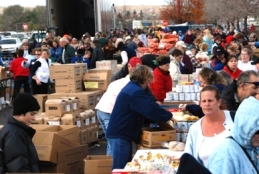
Nearly 9 million Americans 50 and older face the risk of hunger according to new research commissioned by AARP Foundation. The report, “Food Insecurity Among Older Adults,” found more than nine percent of older Americans were at risk of hunger in 2009 — a 79 percent increase since 2001.
The research, produced by James P. Ziliak of the University of Kentucky and Craig Gundersen of the University of Illinois, is the first of its kind to examine hunger risk among people age 50 to 59—the youngest of the baby boomers. Because they are typically too young for Social Security and too old to qualify for programs designed for families with children, this age group can be hit particularly hard in bad economic times. In 2009, 4.9 million 50- to 59-year-olds were at risk of hunger, representing a staggering 38 percent increase over 2007.
“For the first time, we have a fuller picture of hunger risk among all Americans 50-plus. But sadly, it’s far more bleak than before,” said AARP Foundation President Jo Ann Jenkins. “The recession has taken an especially large toll on older people—particularly those in the middle class. Between 2007 and 2009, the most dramatic increase in food insecurity was among those with annual incomes more than twice the poverty line.”
The report also examined hunger trends among older African Americans and Hispanics, finding that the risk of hunger remains alarmingly higher among these groups than whites. The risk of hunger for African Americans and Hispanics in their 50s was twice that of whites over the years studied. In addition, the study provided detailed analyses of hunger risk across states and major metropolitan areas, finding that hunger risk was notably higher among those residing in the South.
To learn more or download a copy of the policy brief or full report, please visit, http://www.aarp.org/aarp-foundation/info-2011/Foundation_2011_Hunger_Research.html.


